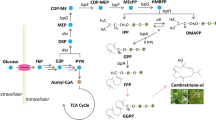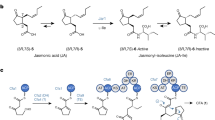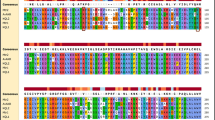Abstract
Main conclusion
We demonstrate the production of a structurally correct cyclotide in rice suspension cells with co-expression of a ligase-type AEP, which unlocks monocotyledons as production platforms to produce cyclotides.
Abstract
Cyclotides are a class of backbone-cyclic plant peptides that harbor a cystine knot composed of three disulfide bonds. These structural features make cyclotides particularly stable, and thus they have attracted significant attention for their use in biotechnological applications such as drug design. Currently, chemical synthesis is the predominant strategy to produce cyclotides for research purposes. However, synthetic production becomes costly both economically and environmentally at large scale. Plants offer an attractive alternative to chemical synthesis because of their lower cost and environmental footprint. In this study, rice suspension cells were engineered to produce the prototypical cyclotide, kalata B1 (kB1), a cyclotide with insecticidal properties from the African plant Oldenlandia affinis. Engineered rice cells produced structurally validated kB1 at yields of 64.21 µg/g (DW), which was dependent on the co-expression of a peptide ligase-competent asparaginyl endopeptidase OaAEP1b from O. affinis. Without co-expression, kB1 was predominantly produced as linear peptide. Through HPLC–MS co-elution, reduction, alkylation, enzymatic digestion, and proton NMR analysis, kB1 produced in rice was shown to be structurally identical to native kB1. This study reports the first example of an engineered plant suspension cell culture with the required molecular machinery for efficient production and cyclisation of a heterologous cyclotide.





Similar content being viewed by others
References
Andersson L, Blomberg L, Flegel M et al (2000) Large-scale synthesis of peptides. Pept Sci 55:227–250
Austin J, Wang W, Puttamadappa S et al (2009) Biosynthesis and biological screening of a genetically encoded library based on the cyclotide MCoTI-I. ChemBioChem 10:2663–2670
Bally J, Nakasugi K, Jia F et al (2015) The extremophile Nicotiana benthamiana has traded viral defence for early vigour. Nat Plants 1:15165
Buyel J (2018) Plants as sources of natural and recombinant anti-cancer agents. Biotechnol Adv 36:506–520
Camarero JA, Kimura R, Woo Y et al (2007) A cell-based approach for the biosynthesis/screening of cyclic peptide libraries against bacterial toxins. Chem Today 25:20–23
Chan LY, Craik DJ, Daly NL (2016) Dual-targeting anti-angiogenic cyclic peptides as potential drug leads for cancer therapy. Sci Rep 6:35347
Chiche L, Heitz A, Gelly JC et al (2004) Squash inhibitors: from structural motifs to macrocyclic knottins. Curr Protein Pept Sci 5:341–349
Christensen AH, Quail PH (1996) Ubiquitin promoter-based vectors for high-level expression of selectable and/or screenable marker genes in monocotyledonous plants. Transgenic Res 5:213–218
Colgrave ML, Craik DJ (2004) Thermal, chemical, and enzymatic stability of the cyclotide kalata B1: the importance of the cyclic cystine knot. Biochemistry 43:5965–5975
Conlan BF, Gillon AD, Barbeta BL et al (2011) Subcellular targeting and biosynthesis of cyclotides in plant cells. Am J Bot 98:2018–2026
Corbin JM, Hashimoto BI, Karuppanan K et al (2016) Semicontinuous bioreactor production of recombinant butyrylcholinesterase in transgenic rice cell suspension cultures. Front Plant Sci 7:412
Craik DJ, Daly NL, Bond T et al (1999) Plant cyclotides: a unique family of cyclic and knotted proteins that defines the cyclic cystine knot structural motif. J Mol Biol 294:1327–1336
Craik DJ, Čemažar M, Wang CK et al (2006) The cyclotide family of circular miniproteins: nature’s combinatorial peptide template. Pept Sci 84:250–266
Craik DJ, Fairlie DP, Liras S et al (2013) The future of peptide-based drugs. Chem Biol Drug Des 81:136–147
Curtis MD, Grossniklaus U (2003) A gateway cloning vector set for high-throughput functional analysis of genes in planta. Plant Physiol 133:462–469
Daly NL, Craik DJ (2000) Acyclic permutants of naturally occurring cyclic proteins characterization of cystine knot and β-sheet formation in the macrocyclic polypeptide kalata B1. J Biol Chem 275:19068–19075
Daly NL, Gustafson KR, Craik DJ (2004) The role of the cyclic peptide backbone in the anti-HIV activity of the cyclotide kalata B1. FEBS Lett 574:69–72
Deng M, Bian H, Xie Y et al (2011) Bcl-2 suppresses hydrogen peroxide-induced programmed cell death via OsVPE2 and OsVPE3, but not via OsVPE1 and OsVPE4, in rice. FEBS J 278:4797–4810
De Veer SJ, Kan MW, Craik DJ (2019) Cyclotides: from structure to function. Chem Rev 119:12375–12421
Eliasen R, Daly NL, Wulff BS et al (2012) Design, synthesis, structural and functional characterization of novel melanocortin agonists based on the cyclotide kalata B1. J Biol Chem 287:40493–40501
Göransson U, Burman R, Gunasekera S et al (2012) Circular proteins from plants and fungi. J Biol Chem 287:27001–27006
Gruber CW, Elliott AG, Ireland DC et al (2008) Distribution and evolution of circular miniproteins in flowering plants. Plant Cell 20:2471–2483
Gunasekera S, Foley FM, Clark RJ et al (2008) Engineering stabilized vascular endothelial growth factor-A antagonists: synthesis, structural characterization, and bioactivity of grafted analogues of cyclotides. J Med Chem 51:7697–7704
Harris KS, Durek T, Kaas Q et al (2015) Efficient backbone cyclization of linear peptides by a recombinant asparaginyl endopeptidase. Nat Commun 6:10199
He Y, Ning T, Xie T et al (2011) Large-scale production of functional human serum albumin from transgenic rice seeds. Proc Natl Acad Sci 108:19078–19083
Hiei Y, Komari T (2008) Agrobacterium-mediated transformation of rice using immature embryos or calli induced from mature seed. Nat Protoc 3:824
Holtz BR, Berquist BR, Bennett LD et al (2015) Commercial-scale biotherapeutics manufacturing facility for plant-made pharmaceuticals. Plant Biotechnol J 13:1180–1190
Huang J, Sutliff TD, Wu L et al (2001) Expression and purification of functional human α-1-antitrypsin from cultured plant cells. Biotechnol Prog 17:126–133
Jackson M, Gilding E, Shafee T et al (2018) Molecular basis for the production of cyclic peptides by plant asparaginyl endopeptidases. Nat Commun 9:2411
Jain M, Nijhawan A, Tyagi AK et al (2006) Validation of housekeeping genes as internal control for studying gene expression in rice by quantitative real-time PCR. Biochem Biophys Res Commun 345:646–651
Jennings C, West J, Waine C et al (2001) Biosynthesis and insecticidal properties of plant cyclotides: the cyclic knotted proteins from Oldenlandia affinis. Proc Natl Acad Sci 98:10614–10619
Ji Y, Majumder S, Millard M et al (2013) In vivo activation of the p53 tumor suppressor pathway by an engineered cyclotide. J Am Chem Soc 135:11623–11633
Jung JW, Kim NS, Jang SH et al (2016) Production and characterization of recombinant human acid α-glucosidase in transgenic rice cell suspension culture. J Biotechnol 226:44–53
Kumamaru T, Uemura Y, Inoue Y et al (2009) Vacuolar processing enzyme plays an essential role in the crystalline structure of glutelin in rice seed. Plant Cell Physiol 51:38–46
Lim Y, Lai K (2017) Generation of transgenic rice expressing cyclotide precursor Oldenlandia affinis kalata B1 protein. J Anim Plant Sci 27:680–684
Liu YK, Lu CW, Chang JY et al (2018) Optimization of the culture medium for recombinant protein production under the control of the αAmy3 promoter in a rice suspension-cultured cell expression system. Plant Cell Tissue Organ Culture 132:383–391
Livak KJ, Schmittgen TD (2001) Analysis of relative gene expression data using real-time quantitative PCR and the 2−ΔΔCT method. Methods 25:402–408
Li M, Li X, Zhou Z et al (2016) Reassessment of the four yield-related genes Gn1a, DEP1, GS3, and IPA1 in rice using a CRISPR/Cas9 system. Front Plant Sci 7:377
Lyon GM, Mehta AK, Varkey JB et al (2014) Clinical care of two patients with Ebola virus disease in the United States. N Engl J Med 371:2402–2409
Main M, Frame B, Wang K (2015) Rice, Japonica (Oryza sativa L.). In: Wang K (ed) Agrobacterium protocols. Springer, Berlin, pp 169–180
Maxmen A (2012) Drug-making plant blooms. Nat News 485:160
Nagaya S, Kawamura K, Shinmyo A et al (2009) The HSP terminator of Arabidopsis thaliana increases gene expression in plant cells. Plant Cell Physiol 51:328–332
Nguyen GK, Zhang S, Nguyen NT et al (2011) Discovery and characterization of novel cyclotides originated from chimeric precursors consisting of albumin-1 chain a and cyclotide domains in the Fabaceae family. J Biol Chem 286:24275–24287
Nguyen GK, Wang S, Qiu Y et al (2014) Butelase 1 is an Asx-specific ligase enabling peptide macrocyclization and synthesis. Nat Chem Biol 10:732
Northfield SE, Wang CK, Schroeder CI et al (2014) Disulfide-rich macrocyclic peptides as templates in drug design. Eur J Med Chem 77:248–257
Park SH, Bang SW, Jeong JS et al (2012) Analysis of the APX, PGD1 and R1G1B constitutive gene promoters in various organs over three homozygous generations of transgenic rice plants. Planta 235:1397–1408
Plan MRR, Saska I, Cagauan AG et al (2008) Backbone cyclised peptides from plants show molluscicidal activity against the rice pest Pomacea canaliculata (golden apple snail). J Agric Food Chem 56:5237–5241
Poon S, Harris KS, Jackson MA et al (2017) Co-expression of a cyclizing asparaginyl endopeptidase enables efficient production of cyclic peptides in planta. J Exp Bot 69:633–641
Poth AG, Colgrave ML, Philip R et al (2011) Discovery of cyclotides in the Fabaceae plant family provides new insights into the cyclization, evolution, and distribution of circular proteins. ACS Chem Biol 6:345–355
Poth AG, Mylne JS, Grassl J et al (2012) Cyclotides associate with leaf vasculature and are the products of a novel precursor in petunia (Solanaceae). J Biol Chem 287:27033–27046
Rehm FB, Jackson MA, De Geyter E et al (2019) Papain-like cysteine proteases prepare plant cyclic peptide precursors for cyclization. Proc Natl Acad Sci 116:7831–7836
Seydel P, Walter C, Dörnenburg H (2009) Scale-up of Oldenlandia affinis suspension cultures in photobioreactors for cyclotide production. Eng Life Sci 9:219–226
Smirnov I, Zhu X, Taylor T et al (2004) Suppression of α-cyano-4-hydroxycinnamic acid matrix clusters and reduction of chemical noise in MALDI-TOF mass spectrometry. Anal Chem 76:2958–2965
Tam JP, Lu Y-A, Yu Q (1999) Thia zip reaction for synthesis of large cyclic peptides: mechanisms and applications. J Am Chem Soc 121:4316–4324
Vamvaka E, Arcalis E, Ramessar K et al (2016) Rice endosperm is cost-effective for the production of recombinant griffithsin with potent activity against HIV. Plant Biotechnol J 14:1427–1437
Vranken WF, Boucher W, Stevens TJ et al (2005) The CCPN data model for NMR spectroscopy: development of a software pipeline. Proteins Struct Funct Bioinform 59:687–696
Wang CK, Gruber CW, Cĕmažar M et al (2014) Molecular grafting onto a stable framework yields novel cyclic peptides for the treatment of multiple sclerosis. ACS Chem Biol 9:156–163
Wang W, Zhou XM, Xiong HX et al (2018) Papain-like and legumain-like proteases in rice: genome-wide identification, comprehensive gene feature characterization and expression analysis. BMC Plant Biol 18:87
Weigel D, Glazebrook J (2006) Transformation of agrobacterium using electroporation. CSH Protoc 2006:1–13
Wong CT, Rowlands DK, Wong CH et al (2012) Orally active peptidic bradykinin B1 receptor antagonists engineered from a cyclotide scaffold for inflammatory pain treatment. Angew Chem 124:5718–5722
Yamada K, Basak AK, Goto-Yamada S et al (2019) Vacuolar processing enzymes in the plant life cycle. New Phytol 226:21–31
Acknowledgements
We thank Dr. Deyun Qiu from the Australian National University for the assistance in rice transformation.
Funding
We acknowledge funding from the Australian Research Council (ARC Laureate Fellowship FL150100146 to DC and ARC Grants DP150100443 and DP200101299 to DC, EG, and TD, CE200100012). This research was also supported by a 2015 Ramaciotti Biomedical Research Award and the Simon Axelsen Memorial Fund and by the facilities of the Australian Research Council Centre of Excellence for Innovations in Peptide and Protein Science.
Author information
Authors and Affiliations
Corresponding author
Ethics declarations
Conflict of interest
The authors declare that the research was conducted in the absence of any commercial or financial relationships that could be construed as a potential conflict of interest.
Consent for publication
Yes.
Availability of data and material
All data supporting the findings of this study are available from the corresponding authors upon request.
Additional information
Communicated by R. George Ratcliffe.
Publisher's Note
Springer Nature remains neutral with regard to jurisdictional claims in published maps and institutional affiliations.
Electronic supplementary material
Below is the link to the electronic supplementary material.
Rights and permissions
About this article
Cite this article
Qu, H., Jackson, M.A., Yap, K. et al. Production of a structurally validated cyclotide in rice suspension cells is enabled by a supporting biosynthetic enzyme. Planta 252, 97 (2020). https://doi.org/10.1007/s00425-020-03505-z
Received:
Accepted:
Published:
DOI: https://doi.org/10.1007/s00425-020-03505-z




